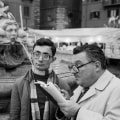Photography is a powerful medium that can capture moments in time and create lasting memories. But to get the most out of your photoshoot, you need to be able to effectively direct models to produce the perfect shot. Directing models during photoshoots requires an understanding of body language, communication, and psychology to get the best out of your subjects. In this article, we'll provide tips on how to get the most out of your photoshoots by directing models and getting the best results.
Directing Models During Photoshoots
is essential for getting the most out of your shoot.Having the right direction for your models helps set the scene, capture the perfect shot and make sure that all the details are perfect. Knowing how to light a scene, what poses work best for a particular look, and how to keep the energy up during a photoshoot are all key elements for success. The benefits of having a well-directed photoshoot are numerous. Proper lighting can make or break a shot, and having the right lighting setup can help create the desired atmosphere. Different types of poses can be used to show off specific features or evoke certain emotions from the viewer.
Keeping your models engaged and energized throughout the shoot can also make all the difference in capturing great shots. When it comes to selecting poses for a photoshoot, it is important to consider the type of look you are going for. For example, if you’re shooting for a fashion magazine, you may want to focus on poses that show off clothing in a flattering way. If you’re shooting for an advertisement, you may want to focus on poses that convey a particular emotion or feeling. The key is to keep your models comfortable while also getting the desired shots. In addition to selecting the right poses, it is also important to keep your models engaged and energized throughout the shoot.
This can be accomplished by providing breaks, offering snacks and drinks, and keeping conversation light and fun. You can also encourage your models to experiment with different poses or facial expressions to get more natural-looking shots. Examples of successful photoshoots can provide useful insights into what makes them successful. Looking at photos of celebrities or models that have been professionally shot can provide useful inspiration for your own photoshoots. Paying attention to the lighting, posing and other details can help you recreate similar results. In addition to these tips for directing models during a photoshoot, there are some other important considerations that will help you get the most out of your shoot.
Make sure that you have all the necessary equipment and supplies, such as lights, backdrops, props and lenses. It’s also important to plan out your shots in advance so that you know exactly what you need to do on the day of the shoot. By following these tips and techniques for directing models during a photoshoot, you can ensure that your shots are perfect and capture the desired look and feel. With the right direction and preparation, you can make sure that your photoshoot is a success.
Keeping Models Engaged
When directing models during photoshoots, it is essential to keep them engaged throughout the shoot. Models can easily become bored or frustrated if they are not given enough direction and motivation.This can lead to a lack of enthusiasm and energy, resulting in less than desirable results. To ensure that models remain engaged during the shoot, it is important to provide clear direction and guidance. Explain the desired look of the shot and provide examples of poses and expressions that will help to create the desired result. Additionally, if appropriate, allow models to take on a bit of creative control and experiment with different ideas.
Another key factor for keeping models engaged is providing plenty of breaks. Taking regular breaks allows models to reset and get back into the right mindset for the shoot. It also gives them an opportunity to relax, stretch, and take care of basic needs such as food or water. Keeping models hydrated and fed will help keep them energized throughout the shoot.
Involving models in the creative process is also important for keeping them engaged. Give them the opportunity to provide feedback and suggest ideas. This will help create a more collaborative atmosphere where everyone is invested in the success of the shoot. Finally, it’s important to create an enjoyable atmosphere on set.
Keep conversations light and fun and make sure everyone is having a good time. Having fun will help keep models engaged and energized throughout the shoot.
Examples of successful photoshoots that were able to keep their models engaged throughout include:
The Versace Spring 2021 campaign was able to keep its models energized by featuring a variety of locations, activities, and high energy music. The campaign featured a diverse cast of models, giving them each an opportunity to express their individual personalities.The Gucci Pre-Fall 2020 campaign was also able to keep its models engaged by providing them with a relaxed atmosphere on set. The models were given plenty of breaks throughout the shoot, allowing them to recharge and get back into the right mindset. Overall, having the right direction for your models is essential for getting the most out of your photoshoot. By providing clear direction, allowing for creative control, taking regular breaks, involving the models in the creative process, and creating an enjoyable atmosphere on set, you will be able to ensure that your models remain energized and focused throughout the entire shoot.
Lighting Tips
Lighting is an essential element of any photoshoot, and it can have a significant impact on the overall look and feel of the images.Different types of lighting can be used to create different looks and moods, and it's important to understand how to use them properly in order to get the best results.
Natural Light:
Natural light is one of the most popular types of lighting for photography, and it can be used to create soft, subtle images. Natural light can be used to create a dreamy, romantic atmosphere or a vibrant, energetic vibe. It can also be used to create dramatic shadows and highlights.When using natural light, pay attention to the time of day and the direction of the light, as this will affect the look of your images.
Artificial Light:
Artificial light is great for creating more dramatic and intense images. Artificial light can be used to create dramatic shadows and highlights, and it can also help to make colors stand out. When using artificial light, it's important to consider the intensity of the light, as well as the color temperature of the light source.Different types of artificial lights such as strobes or continuous lights can create different looks.
Examples:
One example of a successful photoshoot that used both natural and artificial light effectively is a fashion shoot by photographer Steve McCurry. He used natural light to create a soft, romantic atmosphere, while also using artificial lights to create dramatic shadows and highlights. Another example of a successful photoshoot that used different types of lighting effectively is a portrait shoot by photographer Annie Leibovitz.She used both natural and artificial light sources to create dramatic images that capture the personality of her subjects.
Posing Tips
Posing TipsPoses can be used to show off certain features, evoke certain emotions, or create an overall look. When it comes to getting the most out of a photoshoot, knowing how to pose your models is essential. Different types of poses work well for different types of shots, so it’s important to understand the desired effect you’re trying to achieve. Here are some tips and techniques for directing models during a photoshoot. When posing models, it’s important to keep in mind the features that you want to highlight.For example, if you’re shooting a fashion spread, you might want to emphasize the clothing by having your model stand up straight and pose in a way that shows off the outfit. If you’re shooting a portrait, you might want to use more relaxed poses that bring out the subject’s personality. Different types of poses can also be used to evoke different emotions. For example, if you’re shooting a romantic scene, having your model lean in close and look into each other’s eyes can create an intimate moment.
If you’re shooting a more action-packed scene, having your model move around and strike dynamic poses can create energy and excitement. It can also be helpful to draw inspiration from successful photoshoots. Look at examples of how other photographers have used different types of poses to capture the desired look. For example, fashion photographer Mario Testino is known for his dynamic poses that emphasize the clothing and capture the energy of the scene.
Similarly, portrait photographer Annie Leibovitz often uses creative posing techniques to bring out her subjects’ personalities. By learning how to use different types of poses effectively, you’ll be able to get the most out of your photoshoot. With the right direction and guidance, you can capture beautiful shots that will stand out from the crowd. In conclusion, having the right direction for your models during photoshoots is essential for getting the most out of your shoot. Lighting tips, posing tips, and engaging your models are all important aspects that can make or break the perfect shot. It's important to be aware of the space you're shooting in and to ensure the lighting is appropriate for the look you're going for.
Additionally, having a variety of poses can create dynamic and interesting images. Keeping your models engaged and motivated throughout the shoot can also be key to getting the desired results. With these tips and techniques in mind, you can be sure that your photoshoot will be a success!.




